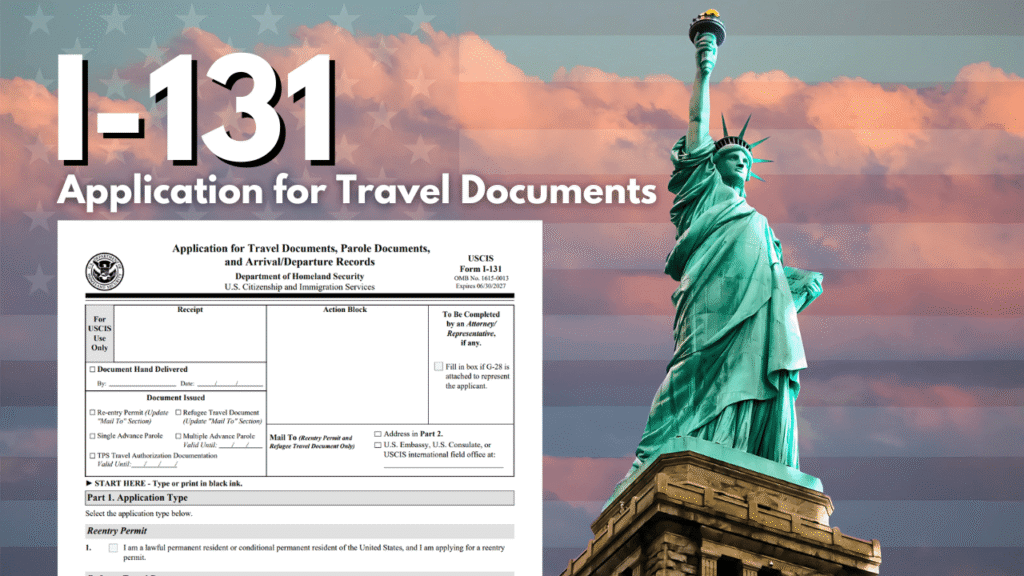A New Path to the United States,
I-131, Application for Travel Documents & Parole Documents

Forms and Document Downloads
Understanding Advanced Parole for Adjustment of Status Applicants: A Practical Guide
If you’re currently navigating the family-based immigration process like I am, you’re in the right place. While I’m not an immigration attorney, the information I share is based on publicly available sources, my personal experience, and valuable insights from subscribers. My goal is to empower you to confidently manage this journey on your own.
Today, I want to provide an updated overview of the Advanced Parole document—a critical travel tool for those applying for Adjustment of Status (Form I-485). You may have already come across some information on this topic, but it’s worth diving deeper to truly understand what this document means and how it works in practice.
What Is Advanced Parole?
Advanced Parole is a travel document issued by USCIS that allows you to temporarily leave and re-enter the United States while your green card application is pending. This is especially useful since many applicants fall out of status during the processing of Form I-485. In theory, Advanced Parole lets you visit your home country—perhaps to see family—and return lawfully while your case is still under review.
However, that’s just in theory. The reality can be more complex, and we’ll explore those nuances later.
If you’re looking for guidance on how to correctly complete Form I-131 (Application for Travel Document), I’ve created a detailed, step-by-step tutorial you can access via the link provided at the top of this page or directly on my YouTube channel.
Key Things to Know About Advanced Parole
- When to Apply
You can apply for Advanced Parole either at the time of submitting your I-485 or later, as long as you include a copy of your I-485 receipt notice. Even if you currently have a valid U.S. visa, once you apply for Adjustment of Status, you must not leave the country unless you have an approved Advanced Parole or your green card in hand.For example, having a 10-year multiple-entry visitor visa does not guarantee re-entry after filing for Adjustment of Status. There are very limited exceptions, mainly for those holding valid L or H visas.
- When to Apply
- Optional but Recommended
Technically, Advanced Parole is optional—but life is unpredictable. Emergency situations can arise, and having this document can make a huge difference. It’s generally a good idea to apply for it alongside your I-485.
- Optional but Recommended
- Separate from Employment Authorization
Advanced Parole is no longer bundled with the Employment Authorization Document (EAD), as was the case in the past with combo cards. USCIS now processes EADs first. If your Advanced Parole is approved, you’ll receive a separate approval notice (not a card) which functions as your travel document.
- Separate from Employment Authorization
What Advanced Parole Is Not
- Not a Visa for Other Countries
Until you’re a U.S. citizen with a U.S. passport, you must still follow the international visa requirements of other countries. Advanced Parole is only for re-entry into the U.S., not for travel across borders abroad.
- Not a Visa for Other Countries
- Not a Travel Document for Asylees or Refugees
Although both applications use Form I-131, individuals with asylum or refugee status need a Refugee Travel Document—not Advanced Parole. Using Advanced Parole in this context may violate your asylum status.
- Not a Travel Document for Asylees or Refugees
- Not Available for Online Filing (in AOS cases)
Adjustment of Status applicants must file Form I-131 by mail. Online submission is not available for this type of request.
- Not Available for Online Filing (in AOS cases)
Processing Times and Expedited Requests
Unfortunately, Advanced Parole is not a priority for USCIS, and processing times can be quite lengthy, ranging anywhere from 9 months to 18 months. In some cases, you may receive your green card before your travel document is even processed.
If you’re in a life-or-death emergency, you may request an expedited Advanced Parole. To do this, you must call the USCIS Contact Center (note: it can take time to reach a live representative). You can also use the USCIS online appointment tool to schedule an InfoPass appointment at your local field office.
For emergency requests, you’ll need to:
- Submit a new Form I-131
- Submit a new Form I-131
- Pay the filing fee
- Pay the filing fee
- Provide documentation of the emergency
Keep in mind that emergency Advanced Parole is typically valid for a short period, often just 2 to 4 weeks.
What Happens After You Apply?
After you file, you’ll receive:
- A receipt notice (Form I-797C)
- A biometrics appointment notice (in some cases)
- Later, if approved, you’ll get a paper approval notice, which serves as your official travel authorization
🔔 Important: USCIS no longer issues “combo cards” that include both work and travel authorization. You will receive your EAD (work permit) separately via Form I-765 and Advanced Parole as a distinct paper notice.
I hope this information helps you better understand the Advanced Parole process. If you have more questions, feel free to explore additional resources on the site or reach out. Thanks for visiting—and best of luck with your immigration journey!